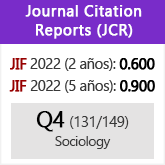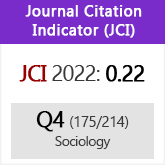Una revisión crítica de la hipótesis del cerebro social de Dunbar
DOI:
https://doi.org/10.3989/ris.2016.74.3.037Palabras clave:
Cognición, Evolución, Grupo, Neocórtex, SocialidadResumen
La hipótesis del cerebro social de Dunbar constituye una posición influyente entre aquellas que relacionan la evolución de la cognición y la socialidad humanas. En este trabajo, tras presentar los puntos esenciales de su teoría, discutimos las evidencias paleo-antropológicas y sociales en las que se sustenta. También señalamos algunas limitaciones. Tales limitaciones tienen que ver con la estrategia general de buscar relaciones lineales entre diferentes rasgos, la insuficiente atención a las capacidades mentales que hacen posible la vida social humana, y a la diversidad de las estructuras sociales efectivas. Presentamos nuestra forma de complementar el enfoque de Dunbar al centrarnos en el papel que juega la confianza como cemento de la sociedad y para explicar la diversidad
Descargas
Citas
Acedo-Carmona, C. and Gomila, A. 2014. "Personal trust increases cooperation beyond general trust". PloS ONE 9(8): e105559. http://dx.doi.org/10.1371/journal.pone.0105559 PMid:25144539 PMCid:PMC4140793
Aiello, L. and Dunbar, R. 1993. "Neocortex size, group size and the evolution of language". Current Anthropology 34: 184-193. http://dx.doi.org/10.1086/204160
Barrett, L., Henzi, P. and Dunbar, R.I.M. 2003. "Primate cognition: from 'what now?' to 'what if?'". Trends in Cognitive Sciences 7, 11: 494-497. http://dx.doi.org/10.1016/j.tics.2003.09.005 PMid:14585446
Byrne, R.W. 1995. The Thinking Ape. Oxford: Oxford University Press.
Byrne, R.W. and Whiten, A. 1988. Machiavellian intelligence. Oxford: Oxford University Press.
Cohen, J.E. 1971. Casual groups of monkeys and men. Cambridge: Harvard University Press. http://dx.doi.org/10.4159/harvard.9780674430556
Croney, C.C. and Newberry, R.C. 2007. "Group size and cognitive processes". Applied Animal Behavior Science 103: 215-228. http://dx.doi.org/10.1016/j.applanim.2006.05.023
Curry, O. and Dunbar, R.I.M. 2011. "Altruism in networks: the effect of connections". Biology Letters 7, 5: 651-653. http://dx.doi.org/10.1098/rsbl.2010.1202 PMid:21411451 PMCid:PMC3169038
Dávid-Barrett, T. and Dunbar, R.I.M. 2012. "Cooperation, behavioural synchrony and status in social networks". Journal of Theoretical Biology 308: 88-95. http://dx.doi.org/10.1016/j.jtbi.2012.05.007 PMid:22609470
Dunbar, R.I.M. 1988. Primate Social Systems. London: Chapman & Hall. http://dx.doi.org/10.1007/978-1- 4684-6694-2
Dunbar, R.I.M. 1991. "Functional significance of social grooming in primates". Folia Primatologica 57: 121-131. http://dx.doi.org/10.1159/000156574
Dunbar R.I.M. 1992. "Neocortex size as a constraint on group size in primates". Journal of Human Evolution 20: 469- 493. http://dx.doi.org/10.1016/0047-2484(92)90081-J
Dunbar, R.I.M. 1993. "Co-evolution of neocortex size, group size and language in humans". Behavioral and Brain Sciences 16, 4: 681-735. http://dx.doi.org/10.1017/S0140525X00032325
Dunbar, R.I.M. 1995. "Neocortex size and group size in primates: a test of the hypothesis". Journal of Human Evolution 28: 287-296. http://dx.doi.org/10.1006/jhev.1995.1021
Dunbar, R.I.M., Marriott, A. and Duncan, N.D.C. 1997. "Human conversational behaviour". Human Nature 8, 3: 231- 246. http://dx.doi.org/10.1007/BF02912493 PMid:26196965
Dunbar, R.I.M. 1998. "The social brain hypothesis". Evolutionary Anthropology 6, 5: 178-190. http://dx.doi.org/10.1002/(SICI)1520-6505(1998)6:5<178::AID-EVAN5>3.0.CO;2-8
Dunbar, R.I.M. 2003. "The social brain: mind, language, and society in evolutionary perspective". Annual Review of Anthropology 32:163-181. http://dx.doi.org/10.1146/annurev.anthro.32.061002.093158
Dunbar, R.I.M. and Shultz, S. 2007a. "Evolution in the social brain". Science 317: 1344-1347. http://dx.doi.org/10.1126/science.1145463 PMid:17823343
Dunbar, R.I.M. and Shultz, S. 2007b. "Understanding primate brain evolution". Philosophical Transactions of the Royal Society B 362: 649-658. http://dx.doi.org/10.1098/rstb.2006.2001 PMid:17301028 PMCid:PMC2346523
Dunbar, R.I.M. 2009a. "The social brain hypothesis and its implications for social evolution". Annals of Human Biology 36, 5: 562-572. http://dx.doi.org/10.1080/03014460902960289 PMid:19575315
Dunbar, R.I.M. 2009b. "Why only humans have language". Pp. 12-35 in The Prehistory of Language. 1st ed. New York: Oxford University Press. http://dx.doi.org/10.1093/acprof:oso/9780199545872.003.0002
Dunbar, R.I.M. 2010. "The social role of touch in humans and primates: behavioural function and neurobiological mechanisms". Neuroscience and Biobehavioral Reviews 34: 260-268. http://dx.doi.org/10.1016/j.neubiorev.2008.07.001 PMid:18662717
Dunbar, R.I.M. 2012a. "Bridging the bonding gap: the transition from primates to humans". Philosophical Transactions of the Royal Society B 367: 1837-1846. http://dx.doi.org/10.1098/rstb.2011.0217 PMid:22641822 PMCid:PMC3367699
Dunbar, R.I.M. 2012b. "Social cognition on the Internet: testing constraints on social network size". Philosophical Transactions of the Royal Society B 367: 2192-2201. http://dx.doi.org/10.1098/rstb.2012.0121 PMid:22734062 PMCid:PMC3385686
Finlay, B.L. and Darlington, R.B. 1995. "Linked regularities in the development and evolution of mammalian brains". Science 268: 1578-1584. http://dx.doi.org/10.1126/science.7777856 PMid:7777856
Fletcher, P., Happé, F., Frith, U., Baker, S.C., Dolan, R.J., Frakowiak, R.S.J. and Frith, C.D. 1995. "Other minds in the brain: a functional imaging study of "theory of mind" in story comprehension". Cognition 57, 2: 109– 128. http://dx.doi.org/10.1016/0010-0277(95)00692-R
Freeberg, T.M., Dunbar, R.I.M. and Ord, T.J. 2012. "Social complexity as a proximate and ultimate factor in communicative complexity". Philosophical Transactions of the Royal Society B 367: 1785-1801. http://dx.doi.org/10.1098/rstb.2011.0213 PMid:22641818 PMCid:PMC3367695
Henzi, S.P., de Sousa Pereira, L.F., Hawker-Bond, D., Stiller, J., Dunbar, R.I.M. and Barrett, L. 2007. "Look who's talking: developmental trends in the size of conversational cliques". Evolution and Human Behavior 28: 66-74. http://dx.doi.org/10.1016/j.evolhumbehav.2006.07.002
Hill, R.A. and Dunbar, R.I.M. 1998. "An evaluation of the roles of predation rate and predation risk as selective pressures on primate grouping behaviour". Behaviour 135: 411- 430. http://dx.doi.org/10.1163/156853998793066195
Hill, R.A. and Dunbar, R.I.M. 2003. "Social network size in humans". Human Nature 14, 1: 53-72. http://dx.doi.org/10.1007/s12110-003-1016-y PMid:26189988
Humphrey, N.K. 1976. "The social function of intellect". Pp. 303- 317 in Growing Points in Ethology. 1st ed. Cambridge: Cambridge University Press.
Hutchinson, S., Hui-Lin Lee, L., Gaab, N. and Schlaug, G. 2003. "Cerebellar volume of musicians". Cerebral Cortex 13, 9: 943-949. http://dx.doi.org/10.1093/cercor/13.9.943 PMid:12902393
Kinderman, P., Dunbar, R., Bentall, R.P. 1998. "Theory-of-mind deficits and causal attributions". British Journal of Psychology 89: 191-204. http://dx.doi.org/10.1111/j.2044-8295.1998.tb02680.x
Kudo, H. and Dunbar, R.I.M. 2001. "Neocortex size and social network size in primates". Animal Behaviour 62: 711- 722. http://dx.doi.org/10.1006/anbe.2001.1808
Lehmann, J., Korstjens, A.H. and Dunbar, R.I.M. 2007. "Group size, grooming and social cohesion in primates". Animal Behaviour 74: 1617-1629. http://dx.doi.org/10.1016/j.anbehav.2006.10.025
Lewis, P.A., Rezaie, R., Brown, R., Roberts, N. and Dunbar, R.I.M. 2011. "Ventromedial prefrontal volume predicts understanding of others and social network size". Neuroimage 57: 1624-1629. h http://dx.doi.org/10.1016/j.neuroimage.2011.05.030 PMid:21616156
Lin, N. 1999. "Building a network theory of social capital". Connections 22: 153-159.
Machin, A.J. and Dunbar, R.I.M. 2011. "The brain opioid theory of social attachment: a review of the evidence". Behaviour 148, 9-10: 985-1025.
McNab, B.K. and Eisenberg, J.F. 1989. "Brain size and its relation to the rate of metabolism in mammals". American Naturalist 133:157-167. http://dx.doi.org/10.1086/284907
McPherson, M., Smith-Lovin, L., Brashears, M.E. 2006. "Social isolation in America: changes in core discussion networks over two decades". American Sociological Review 71: 353- 375. http://dx.doi.org/10.1177/000312240607100301
Mesoudi, A., Whiten, A. and Dunbar, R.I.M. 2006. "A bias for social information in human cultural transmission". British Journal of Psychology 97: 405-423. http://dx.doi.org/10.1348/000712605X85871 PMid:16848951
Miller, G.A. 1956 "The magical number seven, plus or minus two: some limits on our capacity for processing information". Psychological Review 63: 81-97. http://dx.doi.org/10.1037/h0043158 PMid:13310704
Mok, D., Wellman, B., Basu, R. 2007. "Did distance matter before the Internet? Interpersonal contact and support in the 1970s". Social Networks 29: 430-461. http://dx.doi.org/10.1016/j.socnet.2007.01.009
Moll, H. and Tomasello, M. 2007. "Cooperation and human cognition: the Vygotskian intelligence hypothesis". Philosophical Transactions of the Royal Society B 362: 639-648. http://dx.doi.org/10.1098/rstb.2006.2000 PMid:17296598 PMCid:PMC2346522
Powell, J., Lewie, P.A., Roberts, N., García-Fi-ana, M. and Dunbar, R.I.M. 2012. "Orbital prefrontal cortex volume predicts social network size: an imaging study of individual differences in humans". Proceedings of the Royal Society B 279, 1736: 2157-2162. http://dx.doi.org/10.1098/rspb.2011.2574 PMid:22298855 PMCid:PMC3321718
Roberts, S.G.B., Wilson, R., Fedurek, P. and Dunbar, R.I.M. 2008. "Individual differences and personal social network size and structure". Personality and Individual Differences 44: 954-964. http://dx.doi.org/10.1016/j.paid.2007.10.033
Roberts, S.G.B., Dunbar, R.I.M., Pollet, T.V. and Kuppens, T. 2009. "Exploring variation in active network size: Constraints and ego characteristics". Social Networks 31: 138-146. http://dx.doi.org/10.1016/j.socnet.2008.12.002
Roberts, S.G.B. and Dunbar, R.I.M. 2010. "The costs of family and friends: an 18-month longitudinal study of relationship maintenance and decay". Evolution and Human Behavior 32: 186–197. http://dx.doi.org/10.1016/j.evolhumbehav.2010.08.005
Shultz, S. and Dunbar, R.I.M. 2006. "Both social and ecological factors predict ungulate brain size". Proceedings of the Royal Society B 22, 273, 1583: 207-215. http://dx.doi.org/10.1098/rspb.2005.3283
Shultz, S. and Dunbar, R.I.M. 2007. "The evolution of the social brain: anthropoid primates contrast with other vertebrates". Proceedings of the Royal Society B 274: 2429-2436. http://dx.doi.org/10.1098/rspb.2007.0693 PMid:17652066 PMCid:PMC2274976
Shultz, S., Nelson, E. and Dunbar, R.I.M. 2012. "Hominin cognitive evolution: identifying patterns and processes in the fossil and archaeological record." Philosophical Transactions of the Royal Society B 367: 2130-2140. http://dx.doi.org/10.1098/rstb.2012.0115 PMid:22734056 PMCid:PMC3385680
Stiller, J. and Dunbar, R.I.M. 2007. "Perspective-taking and memory capacity predict social network size". Social Networks 29: 93-104. http://dx.doi.org/10.1016/j.socnet.2006.04.001
Sutcliffe, A., Dunbar, R.I.M., Binder, J. and Arrow, H. 2011. "Relationships and the social brain: integrating psychological and evolutionary perspectives". British Journal of Psychology 103: 149-168 . http://dx.doi.org/10.1111/j.2044-8295.2011.02061.x PMid:22506741
Utz, S. 2007. "Media use in long-distance friendships". Information, Communication and Society 10: 694-713. http://dx.doi.org/10.1080/13691180701658046
Van Schaik, C.P. 1983. "Why are diurnal primates living in groups?" Behaviour 87:120-144. http://dx.doi.org/10.1163/156853983X00147
Zhou, W.X., Sornette, D., Hill, R.A. and Dunbar, R.I.M. 2005. "Discrete hierarchical organization of social group sizes". Proceedings of the Royal Society B 272: 439- 444. http://dx.doi.org/10.1098/rspb.2004.2970 PMid:15734699 PMCid:PMC1634986
Publicado
Cómo citar
Número
Sección
Licencia
Derechos de autor 2016 Consejo Superior de Investigaciones Científicas (CSIC)

Esta obra está bajo una licencia internacional Creative Commons Atribución 4.0.
© CSIC. Los originales publicados en las ediciones impresa y electrónica de esta Revista son propiedad del Consejo Superior de Investigaciones Científicas, siendo necesario citar la procedencia en cualquier reproducción parcial o total.Salvo indicación contraria, todos los contenidos de la edición electrónica se distribuyen bajo una licencia de uso y distribución “Creative Commons Reconocimiento 4.0 Internacional ” (CC BY 4.0). Puede consultar desde aquí la versión informativa y el texto legal de la licencia. Esta circunstancia ha de hacerse constar expresamente de esta forma cuando sea necesario.
No se autoriza el depósito en repositorios, páginas web personales o similares de cualquier otra versión distinta a la publicada por el editor.

















